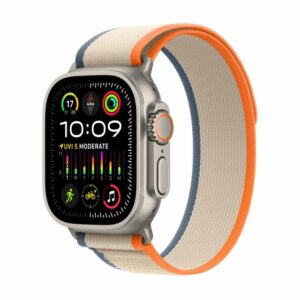


Welcome to the world of heart rate variability (HRV). In this guide, we will be discussing everything you need to know about understanding your variable heart rate – what it means, how it affects your overall health, and how you can track and improve it.
Whether you’re a runner looking to optimise your performance or just someone curious about your own body’s functions, understanding HRV can provide valuable insights into your physical well-being. So let’s dive in!
HRV refers to the variation in time between each heartbeat. In other words, it measures the changes in the intervals between your heartbeats, rather than just looking at your average heart rate. Heart rate variability metrics are crucial for assessing cardiovascular health, as they provide detailed insights into the physiological state of the autonomic nervous system through various measurement techniques.
This variability is a natural occurrence and is influenced by many factors such as exercise, hormonal reactions, metabolic processes, cognitive processes, stress, and recovery. Our body’s autonomic nervous system (ANS) controls these fluctuations and plays a crucial role in maintaining our overall health.
Heart rate variability (HRV) is the natural variation in the time interval between consecutive heartbeats. This variation is measured by analysing the beat-to-beat intervals, also known as the R-R intervals. Essentially, HRV reflects the ability of the autonomic nervous system (ANS) to regulate the heart rate in response to various physiological and environmental factors. These factors include respiration, exercise, hormonal changes, metabolic processes, cognitive activities, stress, and recovery. Understanding heart rate variability (HRV) can provide valuable insights into the body’s adaptability and overall health.
HRV is considered to be a marker of our body’s ability to adapt and respond to different stressors. A higher HRV indicates that our body has a stronger autonomic nervous system, which can quickly adjust to changes in our environment. High heart rate variability suggests a well-regulated balance between the body’s stress and relaxation responses.
On the other hand, a lower HRV can suggest an imbalance in our ANS and may indicate a higher risk for various health issues such as cardiovascular diseases, diabetes, and even mental health disorders like anxiety and depression. Low heart rate variability is linked to higher risks of cardiovascular conditions and can reflect underlying heart issues.
Yes, heart rate variability does matter. As mentioned earlier, a higher HRV is associated with better overall health and lower risk for various diseases. Furthermore, research has also shown that individuals with higher HRV tend to have better physical fitness, cognitive performance, and emotional well-being.
Respiratory sinus arrhythmia (RSA) plays a crucial role in HRV, serving as an indicator of autonomic nervous system function. RSA shows how respiration influences heart rate through vagal modulation, particularly during cycles of inhalation and exhalation, highlighting the dynamic interplay between sympathetic and parasympathetic activity.
On the other hand, a lower HRV has been linked to an increased risk of mortality in individuals with chronic illnesses such as heart disease or diabetes. It can also indicate poor recovery from exercise or stress, which can lead to burnout and fatigue.
Therefore, understanding your HRV can provide valuable insights into your current health status and help you make necessary lifestyle changes to improve it.

For runners, HRV is particularly important as it can indicate their body’s readiness for intense training or competition. A higher HRV indicates that the body is well-rested and recovered, making it more resilient to intense exercise.
Monitoring HRV can also help prevent overtraining and injury as it can indicate when the body needs more rest and recovery. By tracking your HRV, you can adjust your training intensity and volume accordingly, leading to better overall performance.
As mentioned earlier, our body’s ANS plays a crucial role in regulating HRV. It is composed of two branches – the sympathetic and parasympathetic nervous systems.
The sympathetic branch is responsible for our “fight or flight” response, which prepares our body for physical activity and stress. On the other hand, the parasympathetic branch is responsible for our “rest and digest” response, which helps us relax and recover.
A healthy balance between these two branches is essential for maintaining a high HRV. However, chronic stress or unhealthy lifestyle habits can lead to an imbalance in the ANS, resulting in a lower HRV.
Maintaining a balance between the sympathetic and parasympathetic nervous systems is crucial for optimal health and HRV. Here are some tips to help you achieve this balance:
By incorporating these habits into your lifestyle, you can support both branches of your ANS and improve your overall HRV.
There are various methods for measuring HRV, but the most common way is through a heart rate monitor. These devices can track your heart rate and provide insights into your HRV by measuring the changes in the time between each beat.
Many runners opt to wear a smartwatch that measures heart rate variability. We highly recommend the Apple Watch or the Whoop Watch.

The Whoop Watch is a fitness and health wearable designed to monitor various aspects of your well-being, including sleep, strain, recovery, and overall health. It is known for its advanced data accuracy, utilising multiple LEDs and photodiodes to frequently sample your biometric data. The device provides detailed insights into your heart rate, heart rate variability (HRV), and sleep stages, helping users optimise their health and performance.
There are several technologies available for measuring HRV, each with its own advantages. The electrocardiogram (ECG) is considered the gold standard for HRV measurement because it directly reflects the heart’s electrical activity. Photoplethysmography (PPG) is another method that measures the wave of blood flow and calculates the inter-beat interval (IBI). Ballistocardiography (BCG) is a less common method that detects the mechanical activity of the heart. While each method can provide useful HRV data, it’s important to choose the one that best fits your needs and circumstances.
By now, you may be wondering how tracking your HRV can improve your running performance. Here are a few ways it can help:
Heart rate variability is an essential measure of our body’s ability to adapt and respond to various stressors. It plays a crucial role in maintaining our overall health and can provide valuable insights for runners looking to improve their performance.
Various factors can affect a person’s HRV, including:
By understanding these factors, individuals can make necessary lifestyle changes to improve their HRV and overall health. Additionally, tracking HRV can help identify any changes or patterns related to these factors, providing valuable information for better self-care.
As we age, our heart rate variability tends to decrease. Research has shown that the most significant decline in HRV occurs between the second and third decades of life. For individuals aged 40 to 100 years, there is a linear decline in several HRV parameters, including SDNN, SDANN, and the SDNN index. Interestingly, some metrics like RMSSD and pNN50 follow a U-shaped pattern, decreasing from ages 40 to 60 and then increasing after age 70. Understanding these age-related changes in HRV can help us better manage our cardiovascular health and overall well-being as we grow older.
The data: The above heart rate variability (HRV) values provided are general estimates and may not accurately reflect individual variations. HRV can be influenced by numerous factors, including physical fitness, stress levels, lifestyle, and overall health. These values are not intended to diagnose, treat, or prevent any medical condition. Always consult with a healthcare professional for personalised medical advice and before making any significant changes to your health or fitness regimen.
HRV can be improved through lifestyle habits such as regular exercise, stress management, adequate sleep, and healthy eating. Some tips for improving your HRV include:
By incorporating these habits into your routine, you can support both branches of your ANS and improve your overall HRV. This can lead to better performance in not just running but all aspects of life.
Despite the growing popularity of tracking HRV, there are still some misconceptions surrounding it. Here are a few common myths about HRV and the truth behind them:
It is worth noting that HRV is different to resting heart rate and heart rate zones. While HRV measures the variation between heartbeats, resting heart rate is simply the number of times your heart beats per minute when you are at rest. Heart rate zones, on the other hand, are used to determine different levels of intensity during exercise.
If you’re curious about finding out more about heart rate zones, why not check out our Head Coach Mike Gratton’s insightful article, Should I pay attention to my heart rate zone?
HRV metrics can be categorised into three main types: time-domain, frequency-domain, and non-linear measurements. Time-domain indices measure the amount of HRV over monitoring periods that can range from less than a minute to more than 24 hours. Frequency-domain values calculate the absolute or relative amount of signal energy within specific frequency bands. Non-linear measurements assess the unpredictability and complexity of a series of inter-beat intervals (IBIs). Each of these metrics provides unique insights into the functioning of the autonomic nervous system and the body’s ability to adapt to stressors.
Heart rate variability (HRV) has numerous practical applications that can enhance our daily lives. For instance, HRV data can be used to promote health and well-being by helping individuals manage stress and optimise their recovery. In sports, HRV can guide training loads and recovery strategies, ensuring athletes perform at their best while minimising the risk of overtraining. Additionally, HRV can be used to assess physiological reactions to various stimuli, providing valuable feedback for making informed decisions about training, coaching, and overall lifestyle. By leveraging HRV data, we can improve our performance, health, and well-being in meaningful ways.
In conclusion, heart rate variability is a valuable tool for runners looking to improve their performance and overall health. By tracking HRV regularly, sticking to a healthy diet and following a training plan, individuals can support both branches of the ANS and optimise their body’s ability to adapt and respond to various stressors. Why not download one of our training plans and get started today?
Despite some common misconceptions, anyone can benefit from monitoring their HRV. With the advancements in technology, it has become easier than ever to track your HRV with devices like smartwatches or through dedicated apps.
Why wait? Order your Apple Watch or Whoop Watch today to start monitoring your HRV and take control of your training and overall health. With careful monitoring and lifestyle adjustments, you can achieve peak performance and avoid overtraining and potential injuries.

Don’t let your HRV go unnoticed – make it an essential part of your training routine today!
Ready for a speedy marathon challenge? Take a read of our 4 hour pace marathon blog.
Join our mailing list to stay up to date with the latest UK running events, training tips, and exclusive offers on running products. Rest assured, we value your privacy and would never dream of selling your address. Sign up now…
Share this article
The pitter-patter of feet on the pavement, the rhythm of your breath, the wind in...
Designed by our head coach, Mike Gratton, winner of the 1983 London Marathon, this 8-week...
The benefits of our 24-week marathon training plan Look no further if you’re looking for...
For many people, running is seen as a way to improve physical health, lose weight...
Running a marathon distance is the ultimate goal for many runners. It takes dedication, discipline...
A 5K race is an excellent way to challenge yourself and get a great workout....
We’re here to make sure you’re up-to-date with the latest running tips, events and product discounts – we’ve always got your back! Rest assured, we value your privacy and would never dream of selling your address.
BONUS: Sign up today and receive a FREE code for our Sub-4-Hour Marathon Plan